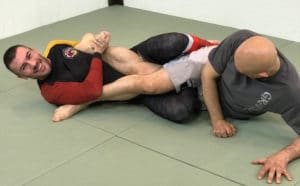Want to tap out less? Let’s take a look at how to get really good at defending against submission attacks.
Today I mostly want to talk about training methodology, not specific techniques per se.
Of course there are definitely many specific defenses that you can use to prevent, defend, and counter any possible submission.
But too many people think that they just have to learn the defense only and then they’ll be good.
You know, guys who hate leglocks and only want to learn leglock counters. Those sorts of guys…
Only training defense is the wrong approach!
To get good at defense you need to understand what someone is trying to do to you. Their setups, their entries, and their finishes.
And the best, fastest way to get to that understanding is to first learn how to do that attack yourself.
You can’t train one without the other. Offense and defense are two sides of the same coin, and they go together.
Erik Paulson, one of my coaches and the founder of Combat Submission Wrestling, started learning leglocks to be able to fight in Japanese MMA where leglocks were very popular. His teacher thought that if Erik learned how to apply leglocks then then he’d be better able to defend against them.
This approach paid off in spades. Not only did Erik avoid getting leglocked in competition, but after several years of fighting he tapped out Kenji Kawaguchi with a kneebar to toehold leglock combo to win the Shooto light-heavyweight championship.
Imagine if you went to a boxing gym and told the trainer that you only want to train bobbing, weaving, ducking, parrying but never learn how to throw a punch. In other words you only wanted to learn defense.
Well, that boxing trainer would look at you like you were daft. This approach doesn’t exist in boxing, so why do we think it works in BJJ?
In fact, learning the offence together with defence doesn’t just apply to submissions.
For example, it also applies to passing the guard and defending the guard.
If you’re on the bottom and the other guy is trying to get past your legs then it’s much, much easier to defend his guard pass in the early stages, before he’s too deep into it.
If you know recognise the early signs of a certain guard pass (a shift in the grips, a change in the stance, a certain kind of pressure, etc) then you’ll be able to start taking preventative actions much sooner than if you’re merely reacting to the pass itself.
So get better at guard passing and you’ll also become better at guard retention. Get better at guard retention and you’ll improve your understanding of guard passing.
The same goes for mount escapes… If you understand how to hold mount then you’ll also understand the key grips and controls you’ll need to deconstruct in order to escape mount.
Early recognition is key, and the best way to recognise attacks earlier is to learn how to do them yourself.
The famous French general Napoleon Buonaparte once said, “You must not fight too often with one enemy, or you will teach him all your art of war.”
Basically he didn’t want other generals to learn his feints, tactics, and strategies because then they’d be able to start recognising those tricks and counter them.
So to get good at defense spend some time working on your offense.
To beat the spider guard learn a little bit about the spider guard.
To get better at defending leglocks learn a little about applying leglocks.
To get better at guard passing learn guard retention, and to improve your guard retention develop your guard passing.
Forewarned is forearmed. You want to learn all of your opponent’s art of war so that he can’t surprise you with them.
Stephan
P.S. There are 3 defensive timings – before, during and after. These timings is how the techniques in my Submission Defense module of the BJJ Master App for Apple and Android devices are organised.
This app covers 36 specific techniques that you can use to escape the 12 most common, most powerful submissions that you’ll run into on a daily basis in your training and competition.
Click Below to Download the Grapplearts BJJ Master App for Free Now
The post How to Get Great at BJJ Defense appeared first on Grapplearts.






